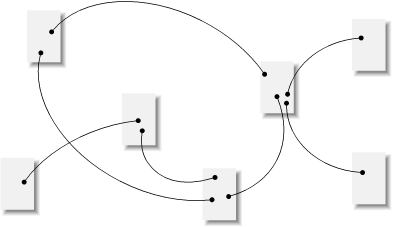WebReference.com - Part 2 of chapter 5 from Information Architecture for the World Wide Web, 2nd Edition. From O'Reilly (4/5).
[previous] [next] |
Information Architecture for the WWW, 2E. Chapter 5: Organization Systems
Hypertext
Hypertext is a relatively recent and highly nonlinear way of structuring information. A hypertext system involves two primary types of components: the items or chunks of information that will be linked, and the links between those chunks. These components can form hypermedia systems that connect text, data, image, video, and audio chunks. Hypertext chunks can be connected hierarchically, non-hierarchically, or both, as shown in Figure 5-17. In hypertext systems, content chunks are connected via links in a loose web of relationships.

Figure 5-17: A network of hypertextual connections
Although this organization structure provides you with great flexibility, it presents substantial potential for complexity and user confusion. Why? Because hypertext links reflect highly personal associations. As users navigate through highly hypertextual web sites, it is easy for them to get lost. It's as if they are thrown into a forest and are bouncing from tree to tree, trying to understand the lay of the land. They simply can't create a mental model of the site organization. Without context, users can quickly become overwhelmed and frustrated. In addition, hypertextual links are often personal in nature. The relationships that one person sees between content items may not be apparent to others.
For these reasons, hypertext is rarely a good candidate for the primary organization structure. Rather, it can be used to complement structures based upon the hierarchical or database models.
Hypertext allows for useful and creative relationships between items and areas in the hierarchy. It usually makes sense to first design the information hierarchy and then identify ways in which hypertext can complement the hierarchy.
[previous] [next] |
Created: September 30, 2002
Revised: September 30, 2002
URL: https://webreference.com/authoring/design/information/iawww/chap5/2/4.html


 Find a programming school near you
Find a programming school near you